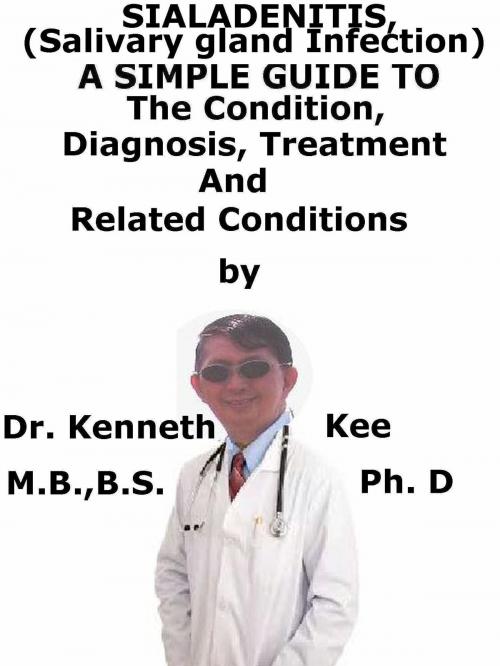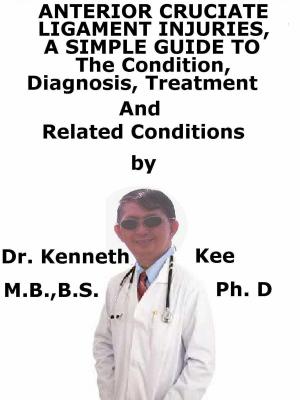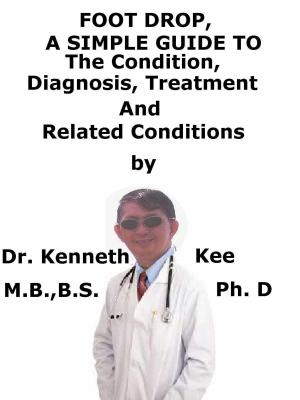Sialadenitis, (Salivary Gland Infection) A Simple Guide To The Condition, Diagnosis, Treatment And Related Conditions
Nonfiction, Health & Well Being, Health, Ailments & Diseases, Oral Health, Medical, Infectious Diseases, General| Author: | Kenneth Kee | ISBN: | 9781370445882 |
| Publisher: | Kenneth Kee | Publication: | May 24, 2017 |
| Imprint: | Smashwords Edition | Language: | English |
| Author: | Kenneth Kee |
| ISBN: | 9781370445882 |
| Publisher: | Kenneth Kee |
| Publication: | May 24, 2017 |
| Imprint: | Smashwords Edition |
| Language: | English |
Sialadenitis is an inflammation of the salivary glands (normally parotid or sub-mandibular).
Sialadenitis of the sub-mandibular gland is a relatively often encountered infection but it is not as frequent as sialadenitis of the parotid gland.
Causes vary from simple infection to autoimmune sources.
Bacterial infections are most frequently due to:
1. Blockage from salivary duct stones
2. Poor cleanliness in the mouth (oral hygiene)
3. Low amounts of water in the body, most often while in the hospital
4. Smoking
Viral infections such as mumps often involve the salivary glands.
Mumps most often involves the parotid salivary gland.
Mumps is a rare disorder today because of the MMR vaccine
Other causes are autoimmune diseases such as autoimmune sialadenitis.
Symptoms are:
1. Acute swelling of the involved salivary glands or entire side of face (particularly in front of the ears, below the jaw, or on the floor of the mouth)
2. Sore throat
3. Fever
4. General toxemia and malaise
5. Pus or purulent saliva may discharge from the Stensen's duct (opening of the salivary duct)
6. Abnormal tastes, foul tastes
7. Decreased ability to open the mouth
8. Dry mouth
9. Mouth or facial "squeezing" pain, especially when eating
10. Redness over the side of the face or the upper neck
In diagnosing the patient with sialadenitis, steps should be taken in the following order:
1. History, physical examination,
Presence of swelling of salivary gland especially the parotid
2. Culture, laboratory investigation,
3. Radiography,
X-rays may reveal the presence of stones in the salivary duct
CT scan, MRI scan or ultrasound is done if the doctor suspects an abscess or to look for stones.
4. Fine-needle aspiration biopsy
Treatment:
In some cases, no treatment is needed.
Treatment from the provider may include:
1. Antibiotic according to sensitivity
Antibiotics are given if the patient has a fever or pus drainage or if the infection is due to bacteria.
Antibiotics are not useful against viral infections.
2. Surgical drainage of pus
Surgery or aspiration is done to drain an abscess if the patient has one
Treatment of sub-mandibular sialadenitis and sialadenosis involves a wide range of approaches, from conservative medical management to more aggressive surgical intervention.
Self-care steps the patient can take at home to help with recovery are:
1. Practice good oral hygiene.
Brush the teeth and floss well at least twice a day.
This may help with healing and prevent an infection from spreading.
Rinse the mouth with warm salt water rinses (one half teaspoon or 3 grams of salt in 1 cup or 240 milliliters of water) to ease pain and keep the mouth moist.
2. Stop smoking if the patient is a smoker, to speed up healing.
3. Drink lots of water and use sugar-free lemon drops to increase the flow of saliva and reduce swelling.
4. Massaging the gland with heat.
5. Use warm compresses on the inflamed gland.
Prevention
In many cases, salivary gland infections cannot be prevented.
1. Proper oral hygiene
Proper oral hygiene may stop some cases of bacterial infection
2. Regular cleaning of gums and teeth by brushing and flossing
3. Gargling of mouth after meals
4. Healthy lifestyle with balanced diet and exercise.
5. Avoid smoking
6. In children wash hands before putting into mouth
TABLE OF CONTENT
Introduction
Chapter 1 Sialadenitis
Chapter 2 Causes
Chapter 3 Symptoms
Chapter 4 Diagnosis
Chapter 5 Treatment
Chapter 6 Prognosis
Chapter 7 Mumps
Chapter 8 Sjogren’s Syndrome
Epilogue
Sialadenitis is an inflammation of the salivary glands (normally parotid or sub-mandibular).
Sialadenitis of the sub-mandibular gland is a relatively often encountered infection but it is not as frequent as sialadenitis of the parotid gland.
Causes vary from simple infection to autoimmune sources.
Bacterial infections are most frequently due to:
1. Blockage from salivary duct stones
2. Poor cleanliness in the mouth (oral hygiene)
3. Low amounts of water in the body, most often while in the hospital
4. Smoking
Viral infections such as mumps often involve the salivary glands.
Mumps most often involves the parotid salivary gland.
Mumps is a rare disorder today because of the MMR vaccine
Other causes are autoimmune diseases such as autoimmune sialadenitis.
Symptoms are:
1. Acute swelling of the involved salivary glands or entire side of face (particularly in front of the ears, below the jaw, or on the floor of the mouth)
2. Sore throat
3. Fever
4. General toxemia and malaise
5. Pus or purulent saliva may discharge from the Stensen's duct (opening of the salivary duct)
6. Abnormal tastes, foul tastes
7. Decreased ability to open the mouth
8. Dry mouth
9. Mouth or facial "squeezing" pain, especially when eating
10. Redness over the side of the face or the upper neck
In diagnosing the patient with sialadenitis, steps should be taken in the following order:
1. History, physical examination,
Presence of swelling of salivary gland especially the parotid
2. Culture, laboratory investigation,
3. Radiography,
X-rays may reveal the presence of stones in the salivary duct
CT scan, MRI scan or ultrasound is done if the doctor suspects an abscess or to look for stones.
4. Fine-needle aspiration biopsy
Treatment:
In some cases, no treatment is needed.
Treatment from the provider may include:
1. Antibiotic according to sensitivity
Antibiotics are given if the patient has a fever or pus drainage or if the infection is due to bacteria.
Antibiotics are not useful against viral infections.
2. Surgical drainage of pus
Surgery or aspiration is done to drain an abscess if the patient has one
Treatment of sub-mandibular sialadenitis and sialadenosis involves a wide range of approaches, from conservative medical management to more aggressive surgical intervention.
Self-care steps the patient can take at home to help with recovery are:
1. Practice good oral hygiene.
Brush the teeth and floss well at least twice a day.
This may help with healing and prevent an infection from spreading.
Rinse the mouth with warm salt water rinses (one half teaspoon or 3 grams of salt in 1 cup or 240 milliliters of water) to ease pain and keep the mouth moist.
2. Stop smoking if the patient is a smoker, to speed up healing.
3. Drink lots of water and use sugar-free lemon drops to increase the flow of saliva and reduce swelling.
4. Massaging the gland with heat.
5. Use warm compresses on the inflamed gland.
Prevention
In many cases, salivary gland infections cannot be prevented.
1. Proper oral hygiene
Proper oral hygiene may stop some cases of bacterial infection
2. Regular cleaning of gums and teeth by brushing and flossing
3. Gargling of mouth after meals
4. Healthy lifestyle with balanced diet and exercise.
5. Avoid smoking
6. In children wash hands before putting into mouth
TABLE OF CONTENT
Introduction
Chapter 1 Sialadenitis
Chapter 2 Causes
Chapter 3 Symptoms
Chapter 4 Diagnosis
Chapter 5 Treatment
Chapter 6 Prognosis
Chapter 7 Mumps
Chapter 8 Sjogren’s Syndrome
Epilogue















